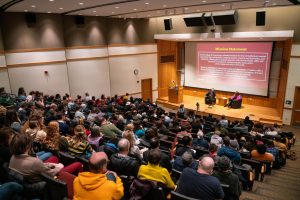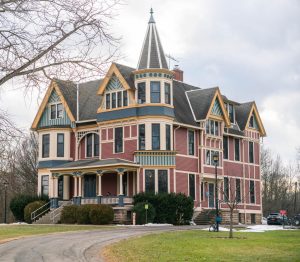Off the Cuff: Marcus Rediker, author of Amistad Rebellion: An Atlantic Odyssey of Slavery and Freedom

Marcus Rediker, professor of History at the University of Pittsburgh
October 9, 2015
Marcus Rediker is a professor of History at the University of Pittsburgh and an author of many books relating to maritime history, including Villains of All Nations: Atlantic Pirates in the Golden Age and The Slave Ship: A Human History, which won the George Washington Book Prize in 2008. Rediker’s last book, The Amistad Rebellion: An Atlantic Odyssey of Slavery and Freedom, inspired him to collaborate with director Tony Buba to make a prizewinning follow-up documentary titled Ghosts of Amistad. The History department and the Bonner Center for Service and Learning invited Rediker to screen the documentary last Monday night and to give a lecture on the Amistad Rebellion on Tuesday.
For readers who aren’t familiar with the history of the Amistad Rebellion, can you give a brief overview of the event?
The Amistad Rebellion took place in 1839. Fifty three Africans captured a slave schooner off the north coast of Cuba [and] sailed it all the way north to the upper end of Long Island, where they were captured by the U.S. government, thrown in jail [and] charged with piracy and murder. There began a tremendous legal struggle for their freedom. Abolitionists flocked to the jail, and this combination of African insurrectionists and mostly white middle-class antislavery activists built together a campaign, which resulted over 19 months [later] in a successful verdict from the United States Supreme Court. Several months after that, the Amistad Africans — the survivors — were able to return home to their native Sierra Leone. The most important thing about it is that this was a very important event in the struggle against slavery in the United States and around the Atlantic.
Was it important in the sense that it changed people’s minds about slavery or rather that it gave abolitionists a symbolic victory?
It was probably the first great victory of the abolitionist movement. So they actually were able to free some people [and] generated tremendous publicity. The abolitionist movement grew, and the abolitionist movement became more radical because the example of a group of people emancipating themselves under arms inflamed the imagination of some abolitionists, including Henry Highland Garnet and John Brown. So it not only expanded the movement — it pushed it in a more militant direction.
You went to Sierra Leone to make your documentary about the rebellion. What did you find there?
We went to Sierra Leone in May 2013 as a spinoff project from the book, which was published in 2012. We had two objectives. One was to see what we could find out about local memory in the Amistad case. I had found in my research which villages the Amistad Africans came from, so we went to 10 villages, gathered up the elders — the keepers of the stories in the village — and, through an interpreter, talked with them about their history, but also about what was remembered there about the Amistad case. The results were mixed. In some villages, they remembered nothing; in other villages, they remembered quite a lot. In fact, [they] had some facts that were not known to historians beforehand, some local knowledge. That was our first objective.
The second was to find this slave-trading factory — that’s what they were called — on the Gallinas coast [of] southern Sierra Leone, where all of the Amistad Africans were held before they were shipped across the Atlantic on a slave ship, and we found it. People had been looking for it for about half a century, and with the help of some fishermen who put us in their canoes and paddled us through a crocodile-infested swamp, we found it. The place is called Lomboko. So those two things — the talks with the elders and the search for Lomboko — were the central parts of the film.
How common were slave ship uprisings at this time?
Slave ship uprisings were fairly common, but successful slave ship uprisings were extremely rare because a whole series of things had to happen for this to work out. Of course, the last and most challenging thing was, could you sail the ship? It turns out the Amistad Africans could; they sailed it 1,400 miles. One of the things that scholarship has revealed overthe last 20 years or so is that revolts were more common than we thought, but still it was very hard to gain control over the slave ship and somehow make your way to freedom. The other case in which it tended to happen was right on the coast of Africa; if people could rise up and seize the ship and then get ashore, they might escape. Once you’ve crossed the Middle Passage — once you’ve crossed the Atlantic — it’s very hard to win your freedom. So in that sense, the Amistad case was an unusual but especially important symbolic example.
I know that the Cuban navigator deceived the Africans and steered the ship toward the U.S. instead of Africa. What does that say about how the navigator thought the U.S. would handle the situation?
Well, here’s what actually happened: They kept two Cuban slave owners alive. One of them was actually a ship captain, so he did know navigation, and they told him to sail the vessel towards the rising sun. Since the rising sun had been at their back when they had crossed the Atlantic, this was the best way of instructing him. So what he would do is, during the daytime, he would sail east, but he kept the sails loose and flapping in the wind so he wouldn’t make too much progress. Then, in the night, he would reverse course and sail back towards the west in the hope that by staying in the busier sea lanes up and down the coast of America and the Caribbean, someone would find him and save him. And that’s what happened — the U.S. navy captured the ship in August 1839.
Is it fair to say that a lot of your work involves refocusing attention on the rebellion itself as opposed to the abolitionists?
While the history of the event is concentrated overwhelmingly on the court case — and the court case was important, no question about it — I think the most important thing was the rebellion. So my work is focused on the African rebels and how they managed to do this most unusual thing — make a revolt and actually win their freedom.
Did those in favor of slavery place the same symbolic significance on the Amistad case that the abolitionists did?
This was out viciously in the press; the pro and antislavery newspapers and individuals fought over this. Some of the coverage of the Amistad case in the proslavery press was really quite extraordinary. I mean it was just pure racist invective: ‘These people are savages; they’re built like monkeys; send them to Cuba; execute them; they’re nothing but slaves.’ But the abolitionists are saying, ‘These people are freedom fighters. They were illegally enslaved, and you need to free them.’ The debate was fierce.
























